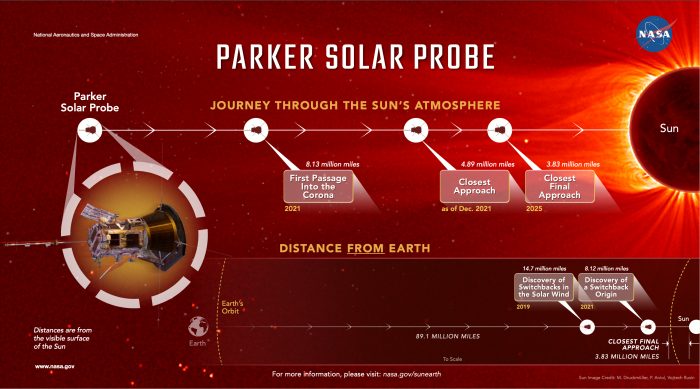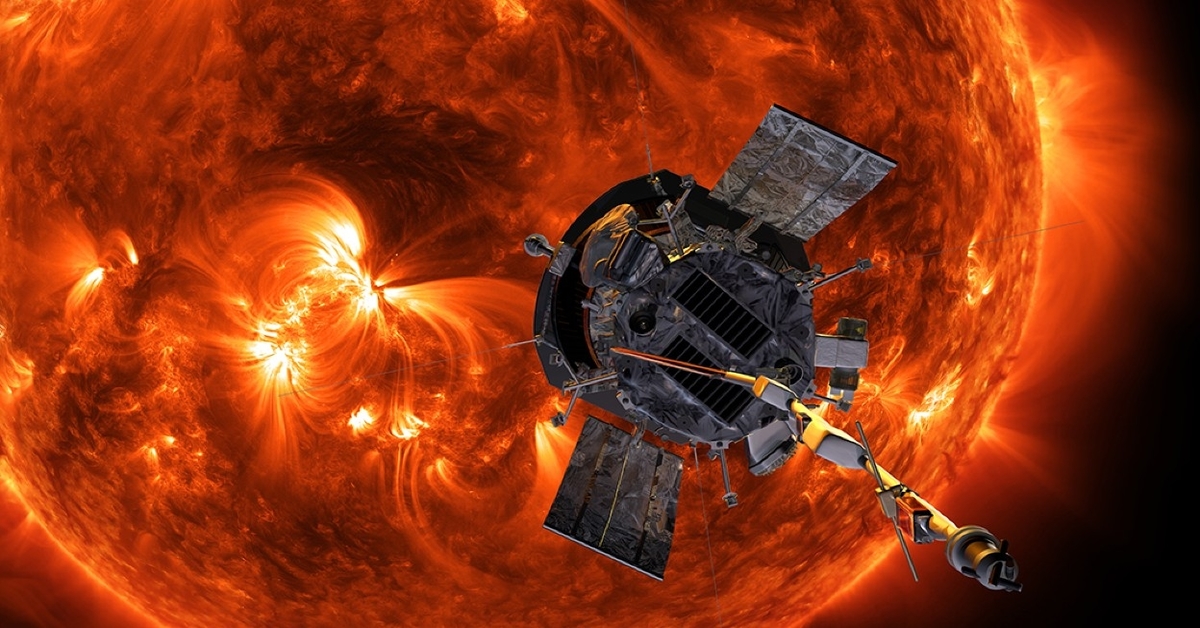In Greek mythology, when Icarus flew too close to the sun, he tumbled out of the sky as his wings melted, fell into the sea and drowned.
Now, NASA can confidently say: I can’t relate to that!
In a first for humanity, a space probe didn’t just go close to the Sun, but also “kissed” it – and managed to survive to tell the tale.
Launched in 2018, NASA’s Parker Solar Probe has now flown through the Sun’s upper atmosphere – the corona – and sampled particles and magnetic fields. It’s a monumental leap for solar science. Just as the Moon landing enabled scientists to understand how the Moon was formed, ultra-close encounters with the Sun will help scientists uncover crucial information about our closest star and its influence on our Solar System.
In the eye of the solar storm.
Parker’s achievement has already answered some burning questions about the Sun.
A fresh paper was published in Physical Review Letters, detailing the data collected by the solar probe as it crossed the much-anticipated boundary – the Alfvén critical surface.
This surface marks the interface between the Sun’s atmosphere and an outer region of space, where solar winds dominate. Since the Nobel-Prize-winning physicist Hannes Alfvén proposed the underlying theory behind the boundary in 1942, scientists have been searching for it ever since.
Previously estimated to be around 6.9 to 13.8 million kilometres (4.3 to 8.6 million miles) above the surface of the Sun, scientists now have a much more accurate figure: 13 million kilometres (8.1 million miles).
But as Parker dipped further into the solar atmosphere at just 10.4 million kilometres (6.5 million miles) above the Sun’s surface, it encountered more strange solar surprises.
The first one is a series of pseudostreamers containing electrically charged material. Passing through these pseudostreamers is akin to flying into the eye of a storm. But once inside them, the conditions quieted, particles slowed and the frequency of switchbacks – unusual kinks in the magnetic field of the solar wind – dropped tremendously. While scientists knew about switchbacks previously, through this fly-by they also found out that the surface of the Sun generates these switchbacks too.
Now how is all this important?
Understanding how these features form on the Sun, and how they influence the solar wind or the eruption of other charged particles, has major implications for us on Earth. Researchers can better study disruptive space weather, such as when solar storms disable satellite communications and even HPC systems, and better prepare for future events. This discovery will also be a key piece of the puzzle in deciphering the forces that power stars, other than the Sun.
Now you might also be wondering: how on Earth did the probe survive the scorching heat of the Sun?
Sunscreen SPF: a bazillion.
If Earth was at one end of a yard-stick and the Sun on the other, Parker will make it to within four inches of the Sun’s surface.
But the key to understanding what keeps the spacecraft and its instruments safe is the concept of heat vs temperature – high temperatures don’t always equate to actually heating an object. While temperature measures how fast particles move, heat measures the total amount of thermal energy the particles transfer. So since space is mostly just space, much fewer particles can transfer thermal energy to the solar probe. Think of the difference between putting your hand in a hot oven vs putting it in boiling water – your hand can withstand significantly higher temperatures for a longer time than in the water, where more hot particles interact with your hand. Similarly, while Parker travels through the solar atmosphere with temperatures of millions of degrees, the surface of the heat shield that protects the probe will only get heated to about 1,370 degrees Celsius (2,500 degrees Fahrenheit).
That’s still spectacularly hot. And the difference between Icarus’ wings and Parker’s shield is that one is made of wax, the other an advanced carbon-composite foam sandwiched between two carbon plates painted white. Tested to withstand up to 1,650 degrees Celsius (3,000 degrees Fahrenheit), the shield keeps the solar probe at a comfortable 30 degrees Celsius (85 degrees Fahrenheit).
So the thermal protection system can handle any heat the Sun can send its way, and Parker can travel inwards safely. Check out this fascinating video of the probe’s journey through the Sun’s corona!
These initial results are just the tip of the sunberg as Parker’s solar voyage is far from over. With 14 more fly-bys to go – the closest approach scheduled for 2025 at a distance of just 6.2 million kilometres (3.8 million miles) from the solar surface – Parker is braving the immense heat, unlocking the mysteries of our home star one solar storm at a time.





































